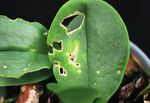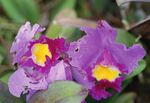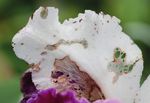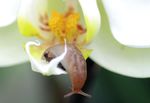Slugs & Snails - HARK Orchideen
←
→
Page content transcription
If your browser does not render page correctly, please read the page content below
Animal pests
Slugs & Snails
ORCHIDEEN
Biology
Slugs and Snails are molluscs (Mollusca). They have a chitinous-like friction plate with numerous teeth, the
so-called radula helps them to literally graze their food from the surface. Snails are crepuscular or nocturne,
during the day they live under barks, pots or between plants. All snails produce slime and are usually very
polyphagous. They lay their eggs in substrate. The young snails that emerge from the eggs look very much like
their parents.
On Orchids, slugs without shells and snails with more or less big shells occur causing more or less damage.
Some snails or slugs can play an important role as carrier of viruses. The most common species of slugs is the
field slug (Deroceras reticulatum Müller). This species can be 50-60 mm long in favourable conditions, the
body is grey to reddish-brown with dark net-like lines and spots. The eggs with diameters of up to 2.0 mm are
usually laid in groups of 4-10 eggs under pots, wood or bark. This species multiplies very quickly, in favourable
climatic conditions in greenhouses, adult field slugs are able to lay eggs every 2 nd or 3 rd day. They mainly eat
plant parts above the ground. They prefer young, soft plant tissue and are therefore often found on young
plants and blossoms.
One species of snails is the orchid snail (Zonitoides arboreus Say). It is a North American species. The shell is
about 2.0-2.5 mm high and 3.5-4.0 mm wide, brown-yellow to red- brown. They live on rotten and living plant
material preferring the latter. This species loves bark substrates and finds ideal living conditions in it. The ent-
ire development takes about 3 months.
Snails usually occur on roots and root necks, they only cause slight direct damage, but create wounds. These
wounds are then used as an entrance for harmful fungi. Snails are usually imported into the greenhouses in
plant substrate, mainly in bark or coconut fibres.
Other snails and slugs in greenhouses that sometimes also eat on orchids are Opeas pumilum Pfeiffer, Oxychi-
lus draparnaudi Beck, Discus rotundatus Müller and Lehmannia marginata Müller. Many snails are imported
from tropical countries in plant material and especially in substrates accompanying that plant material.
www.hark-orchideen.de
All statements without guarantee.Animal pests
Slugs & Snails
ORCHIDEEN
Damage
Snails and slugs cause superficial scraping damage with their scraping tongue on root ends, bulbs and pseu-
dobulbs, leaves and flower buds. When there is more eating activity, small holes are created. On bigger and
thicker leaves, they mainly gnaw the undersides. These feeding marks may scar later on and when the plants
grow, large suberisation can be seen in some cases. The roots are often gnawed close to the root ends and
wounds occur on the roots leading to secondary infestation by secondary parasites. As to Cattleya, Phalae-
nopsis and Phaius, the snails and slugs mainly gnaw their blossoms. Another symptom of snail or slug infesta-
tion is the often large slime traces and irregular looking black dung spots at their feeding sites.
Control
In horticulture, three substances in the form of slug pellets are available: Methiocarb, Metaldehyde and Iron-
III-Phosphate.
Metaldehyde-containing products are effective in temperatures above 20°C and are effective for a longer time.
However, when treated with those products, snails and slugs may recover again after non-lethal intake and
in high humidity, so several repeated treatments are necessary. Snails and slugs that absorb the substance
produce large amounts of slime.
In humid biotopes, Methiocarb is more effective than Metaldehyde. Methiocarb has an ovicide effect, too, it is
effective in low temperatures already but has a shorter period of effectiveness. After absorbing the substan-
ce, the snails and slugs remain active for some time. To improve the effectiveness, water must be available,
in dry conditions the snails or slugs might recover again. There is no slime production as after absorption of
Metaldehyde.
After absorbing Iron-III-Phosphate the animals are supposed to stop eating right away. There is no environ-
mental damage, because the substance is degraded in iron and phosphor. The effectiveness is not based on
dehydration, so there is no reduced effectiveness in humid conditions and no slime production.
Most products have only a relatively short period of effectiveness in very humid air conditions which are usual-
ly found in plant stands in greenhouses. So treatments have to be repeated at regular intervals of at least 3-4
weeks, better would be intervals of about 10 days until no new feeding sites are seen. To improve effective-
ness, spreading combinations of different substances has proved effective in gardening practice.
www.hark-orchideen.de
All statements without guarantee.Animal pests
Slugs & Snails
ORCHIDEEN
Cattleya: scraping damage at flower caused by slug Cattleya: scraping damage at flower caused by slug
Cattleya: scraping damage at flower caused by slug Phalaenopsis: slug damage at youngplant
Phalaenopsis: slug in flower Phalaenopsis: slug in substrate
© Holger Nennmann www.hark-orchideen.de
All statements without guarantee.Animal pests
Slugs & Snails
ORCHIDEEN
orchid snail (Zonitoides arboreus) in substrate
orchid snail (Zonitoides arboreus) below pots
© Holger Nennmann www.hark-orchideen.de
All statements without guarantee.You can also read

























































